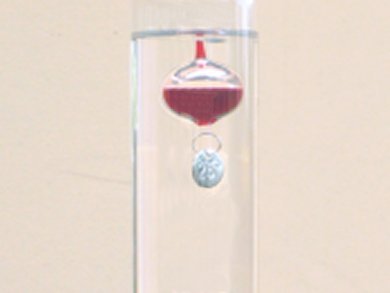A Galilean Thermometer consists of a large glass cylinder filled with a transparent liquid whose density varies as much as possible with temperature. Little sealed glass spheres, each filled with a different colored liquid, float at various heights within the tube. Each glass sphere carries a metal tag, indicating a temperature value. The external temperature corresponds to the tag carried by the glass sphere that is floating at mid-height of the tube.
The underlying principle of this method of temperature measurement is buoyancy. According to the Archimedes’ principle, the buoyant force exerted on an object depends on the weight of the liquid displaced by the object. This corresponds to the product of the object’s volume and the liquid’s density. Because the glass spheres are sealed and have a defined volume, the buoyant force on the spheres, and by this their position in the glass tube, are only determined by the density of the tube’s liquid. If the liquid’s density is lower than a spheres’s effective density, this specific sphere will sink; otherwise, it will float. In the case of equal densities, the sphere floats at mid-height.
The Galilean Thermometer is based on the temperature-dependency of the liquid’s density. With increasing temperature, its density decreases. That makes each bulb change its position: the bulb originally floating at mid-height sinks and another bulb takes on the position at mid-height – the temperature increase is visualized.
Despite the name of the thermometer, Galileo was probably not its true inventor although he certainly gave the initial inspiration. Members of the Florentine Accademia del Cimento (1657–1667) and not Galileo himself accomplished the construction of a first device several years after his death in 1642.
- Galilean Thermometer Not So Galilean,
P. Loyson,
J. Chem. Educ. 2012, 89 (9), 1095–1096.
DOI: 10.1021/ed200793g


